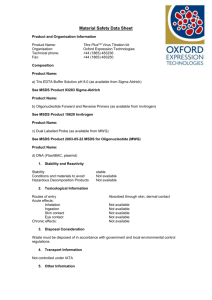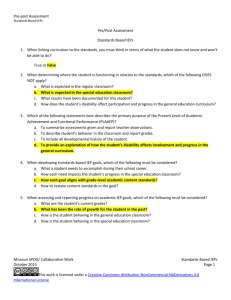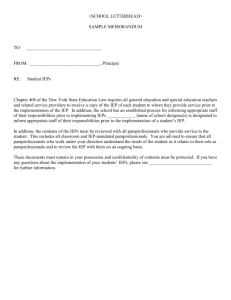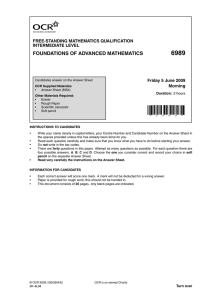What Does Michigan Collect/Report and Why?
advertisement
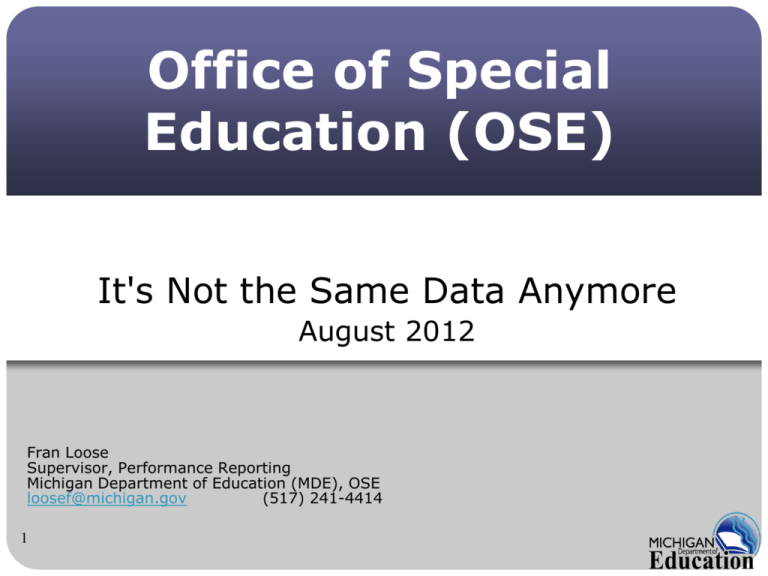
Office of Special Education (OSE) It's Not the Same Data Anymore August 2012 Fran Loose Supervisor, Performance Reporting Michigan Department of Education (MDE), OSE loosef@michigan.gov (517) 241-4414 1 Our Agenda 1. Backdrop Resources 2. 2012-2013 MSDS data collection/reporting changes 3. How to support accurate MSDS data collection/analysis 4. SPP data available on the Wayne State University/Center for Urban Studies website 5. Emerging special education elements in the MISchool Data Portal 2 What Does Michigan Collect/Report and Why? IDEA-Required State Performance Plan Indicators 1– Graduation 2– Dropout 3– Statewide Assessment 4A–Suspension/Expulsion 4B- Susp/Exp by Race/Ethnicity 5– Educational Environments 6– Preschool Ed. Environments 7– Preschool Outcomes 8– Facilitated Parent Involvement 9– Disproportionate Rep. – Child with a Disability 3 10- Disproportionate Rep. – Eligibility Category 11- Child Find 12- Early Childhood Transition 13- Secondary Transition 14- Postsecondary Transition 15- Compliance Findings 16- State Complaints 17- Hearings Adjudicated 18- Resolution Session Agreements 19- Mediation Agreements 20- Timely and Accurate Data What Does Michigan Collect/Report and Why? SPP Compliance Indicators 1– Graduation 2– Dropout 3– Statewide Assessment 4A–Suspension/Expulsion 4B- Susp/Exp by Race/Ethnicity 5– Educational Environments 6– Preschool Ed. Environments 7– Preschool Outcomes 8– Facilitated Parent Involvement 9– Disproportionate Rep. – Child with a Disability 4 10- Disproportionate Rep. – Eligibility Category 11- Child Find 12- Early Childhood Transition 13- Secondary Transition 14- Postsecondary Transition 15- Compliance Findings 16- State Complaints 17- Hearings Adjudicated 18- Resolution Session Agreements 19- Mediation Agreements 20- Timely and Accurate Data What Does Michigan Collect/Report and Why? SPP Results Indicators 1– Graduation 2– Dropout 3– Statewide Assessment 4A–Suspension/Expulsion 4B- Susp/Exp by race/ethnicity 5– Educational Environments 6– Preschool Ed. Environments 7– Preschool Outcomes 8– Facilitated Parent Involvement 9– Disproportionate Rep. – Child with a Disability 5 10- Disproportionate Rep. – Eligibility Category 11- Child Find 12- Early Childhood Transition 13- Secondary Transition 14- Postsecondary Transition 15- Compliance Findings 16- State Complaints 17- Hearings Adjudicated 18- Resolution Session Agreements 19- Mediation Agreements 20- Timely and Accurate Data NEW: OSEP SPP Data Changes Affect How We Use MSDS Data • Dropout–If new calculation methodology implemented, 20092010 dropout rate changes from 6.1% to 25.9%. • State Assessment – AYP adjustment (2011-2012 data), district = 1 large school, no more separate elementary, middle, HS analysis – (3C) Proficiency-- students who have not been enrolled in a building/LEA for a full academic year (FAY) will now be counted. • Disproportionate Representation--Under-representation gone • State Complaints & Hearings Adjudicated gone. Associated data will be submitted via EDFacts. District accountability continues for timely correction of non-compliance. Uncorrected noncompliance reported in Indicator 15. 6 What Does Michigan Collect/Report and Why? IDEA-Required EDFacts Tables 1– 2– 34– 5– 6– 7– 8– 7 Child Count Personnel Educational Environments Exit Suspension/Expulsion Statewide Assessment Due Process Maintenance of Effort & Coordinated Early Intervening Services What Does Michigan Collect/Report and Why? Michigan’s determination from the OSEP—In 2012 Michigan received a “needs assistance”, determination level 2 rating for Part B of IDEA 2004. Elements in LEA Determinations from the OSE--June 2012 ● Performance on each SPP compliance indicator (4B, 9, 10, 11, 12, 13, 15) ● Timely, valid, and reliable data submitted by LEAs o Timely MSDS, CIMS, and 4096 submissions o Consistent collection to collection data on students, or correctly exit students ● Timely IEPs ● Uncorrected noncompliance from other sources 8 ● Audit findings OSE Data Contacts Performance Contact Reporting Staff Oren Christmas 517-335-0394 Data Responsibility for SPP Indicators / EDFacts Tables All SPP Indicators christmaso@mi.gov Jayme Kraus 517-373-0346 Julie Treviño SPP Indicators: 11, 12, 13 517-335-0454 Indicators: 1, 2, 5, robertsonj@mi.gov Tables: Child Count, Ed. Environment, Discipline, Exit, Personnel, Valid, Reliable Data 517-241-0497 517-241-0786 warnerd@mi.gov Debbie Young 517-241-1448 youngd16@mi.gov 9 Timely IEPs All SPP Indicators All SPP Indicators Indicators: 3, 15, 16, 17, 18, 19, 20 Tables: Due Process, Maintenance of Effort/Coordinated Early Intervening Services Indicators: 4, 8, 9, 10, 14 SPP Indicator 15 trevinoj1@mi.gov Darren Warner All SPP Indicators Indicators: 6, 7, 11, 12, 13 krausj1@mi.gov John Robertson Determinations Timely Data SPP Indicators: 4B, 9, 10, 14 State Data Partners • OSE Program Accountability Unit • OSE Continuous Improvement and Compliance Team – CIMS workbooks 3/year www.cenmi.org/cims • OSE Data Advisory Committee • Bureau of Assessment and Accountability • Center for Educational Performance and Information (CEPI) www.michigan.gov/cepi • Office of Great Start • Interagency Information Systems (MI-CIS) • Public Sector Consultants • Wayne State University, Center for Urban Studies www.cus.waye.edu/ecd 10 National Data Partners • National: o Data Accountability Center, Westat www.ideadata.org o Education Information Management Advisory Consortium (EIMAC) 11 CEPI Resources/Contacts • Educational Entity Master (EEM)—updated special education contact, grade levels and center programs • Registry of Educational Personnel (REP) —personnel • Michigan Student Data System (MSDS)—reports and new 2012-2013 aspects • MI School Data Portal—new special education demographics and APR Public Reporting CEPI Customer Support 517-335-0505 / CEPI@michigan.gov 12 Data Accountability Center www.IDEAdata.org • Left Tab: State Data • Center Tab: Data TA Resources • Right Tab: Data Collections Forms 13 Part 2 2012-2013 MSDS data collection/reporting changes … And a few other quick facts 14 Bridge from Early On® (Part C) The collection of Early On data has moved from MI-CIS to MSDS for 2012-2013 • The Early On component collects data relative to children under the age of three (3) who receive services which may or may not include special education • NOTE: Children receiving special education services must be reported in the Special Education Component in addition to the Early On Component. 15 Initial IEP Component Updates • Only report children at least 2½ years of age • New Characteristic: Part C Transition Timeliness – For children referred by Part C prior to age 3 and who have been receiving special education services • NOTE: Children 2-1/2 to 3 years of age transitioning from Part C must have their initial IEP both-– within 30 school days of receiving parental consent or within agreed-upon written extension AND – by their 3rd birthday 16 New Educational Environments in 2011 Educational Environments for Children Three Through Five (3-5) • Time spent with typically developing peers reported by o 10 hours or more per week o Less than 10 hours per week • AND whether the majority of special education service occurs in regular early childhood setting or a separate special education classroom or building • A quick guide, instructions and attached tools are available at: www.michigan.gov/ecse 17 Educational Environments for Children Three Through Five (3-5) MSDS and EDFacts Code 22 23 Early Childhood Special Education Program/Class Home (ages 3-5) 25 Residential Facility 26 Separate School 27 Service Provider Location 46 Regular EC program at least 10 hrs/wk, majority of SE hrs. in EC program (A1) Regular EC program at least 10 hrs/wk, majority of SE hrs. in other location (A2) Regular EC program less than 10 hrs/wk, majority of SE hrs. in EC program (B1) Regular EC program less than 10 hrs/wk, majority of SE hrs. in other location (B2) 47 48 49 18 Description Part B State Annual Performance Report-Indicator 6 Measurement A # of children aged 3 through 5 with IEPs attending a regular early childhood program and receiving the majority of special education and related services in the regular early childhood program (Codes 46 & 48) Measurement B # of children aged 3 through 5 with IEPs attending a separate special education class, separate school or residential facility (Codes 22, 25 & 26) Educational Environments for Children Three Through Five (3-5) Preliminary Indicator 6 Results Special Education Child Count 2011 6A. # of children aged 3 through 5 with IEPs attending a regular early childhood program and receiving the majority of special education and related services in the regular early childhood program (5,743) x 100 = 27.2% Total # of children aged 3 through 5 with IEPs (21,086) 6B. # of children aged 3 through 5 with IEPs attending a separate special education class, separate school or residential facility (9,325) x 100 = 44.2% Total # of children aged 3 through 5 with IEPs (21,086) Calculated using EDFacts Tables submitted to USED/OSEP February 2012 19 Educational Environments for Children Three Through Five (3-5) EDFacts-Table 3 20 Grade 14: Special Education Transition Grade 14 may only be reported if all of the following conditions are met: 1.The student with an IEP is attending a transition program, or is moving from a standard K-12 environment to a transition program. 2.The student with an IEP is 18 years of age or older as of September 1 of the current school year. 3.The student completed or will be completing a high school state assessment in the current school year. 21 In Lieu of Grade 14 If the student with an IEP is • in a graded classroom for either special or general education, report that grade. This includes shared time students who attend graded classrooms in other districts. • only educated in an ungraded setting, report the most appropriate grade based on the student’s age as of December 1 of the current school year. The following is a guideline for districts to follow when assigning a grade based on the student’s age. 22 Ungraded Classrooms Assign to a Grade by Age as of December 1 Age Under 5 5 or 6 years old 7 years old 8 9 10 11 … 18 23 Grade Early Childhood K 1 2 3 4 5 … 12 Code 30 00 01 02 03 04 05 … 12 New CEPI Downloadable SE File ISD DCODE DNAME StudwoI StudwI SpEd% EP EP CI EI HI VI PI SLI ECDD SLD SXI ASD TBI DB OHI AI AA AS 11 11010 Benton Harbor Area Schools 2664 442 14.2% 126 38 <5 <5 <5 75 52 128 <5 6 <5 <5 13 <5 406 <5 15 15050 Charlevoix Public Schools 1034 125 10.8% 6 13 <5 <5 <5 29 <5 53 <5 5 <5 <5 17 12 <5 <5 33 33010 East Lansing School District 3349 316 8.6% 33 13 9 <5 <5 109 10 68 <5 31 <5 <5 36 <5 72 16 29 37010 Mt. Pleasant City School District 3409 625 15.5% 63 18 9 <5 <5 209 <5 215 8 34 <5 <5 56 94 28 9 28 45020 Leland Public School District 567 40 6.6% <5 <5 <5 <5 <5 8 <5 16 <5 5 <5 <5 <5 <5 <5 <5 82 82010 Detroit City School District 58461 11957 17.0% 2341 502 245 56 153 1624 359 4777 310 806 39 <5 745 31 10834 53 82 82702 University Preparatory Academy (PSAD) 1586 142 8.2% 6 <5 70 <5 5 <5 <5 13 <5 138 <5 M Home (0-3) Other <5 <5 <5 43 <5 HS WH HW MR LEP Migrant FRL Bto3 PreK KG 01 02 03 04 05 06 07 08 09 10 11 12 14* F 11 22 <5 <5 <5 412 6 10 29 46 39 34 41 31 38 46 23 33 30 22 14 <5 127 315 <5 <5 <5 101 <5 5 <5 <5 87 <5 <5 13 6 5 9 8 11 14 15 10 10 7 9 8 <5 41 <5 <5 27 182 <5 17 11 <5 144 16 15 22 17 27 23 19 23 24 18 20 25 22 17 22 6 105 211 <5 <5 33 444 <5 17 <5 <5 363 <5 <5 52 35 63 42 47 54 34 42 38 48 58 51 22 39 220 405 <5 <5 7 31 <5 <5 <5 <5 20 <5 <5 <5 <5 <5 <5 <5 6 <5 <5 <5 <5 6 <5 <5 <5 16 <5 <5 692 343 <5 <5 683 <5 9900 394 172 319 546 656 750 875 917 985 936 965 1122 1025 905 895 495 3948 8009 246 <5 <5 <5 <5 <5 114 <5 5 <5 <5 24 <5 <5 <5 6 12 14 13 10 19 13 11 10 15 8 6 <5 41 84 24 101 <5 Data and Reports Downloadable Data File Layout Michigan Student Data System (MSDS) Special Education - Oct 5 Count, Public Data *2011-2012 School Year Column Name ISD DCODE Description ISD Code District Code http://www.michigan.gov/cepi/0,45 46,7-113-21423_30451_37305--,00.html DNAME District Official Name StudwoIEP Number of students without an IEP StudwIEP Number of students with an IEP SpEd% Percentage of students with an IEP in the District CI Number of students with Cognitive Impairment EI Number of students with Emotional Impairment … … OHI Number of students with Other Health Impairment AI Number of American Indian students … … MR Number of Multi-Racial students LEP Number of students who are limited English proficient Migrant Number of students who are migrant FRL Number of students who receive free and/or reduced lunch Bto3 Number of students birth to 3 years old Pre-K Number of pre-kindergarten students KG Number of students in kindergarten … … 14* Number of students in Grade 14 as submitted by the Districts F Number of Female students M Number of Male students 25 26 27 Part 3 How to support accurate MSDS data collection/analysis … And a few other quick facts 28 MSDS—So, How Do I Get Access? • Work with your local MSDS superuser who can assist with authorizations. • Consider requesting viewer rights. • And then, how do I learn to use it? 29 MSDS--So, How Do I Use It? Step 1: Go to http://www.michigan.gov/cepi • Start with CEPI Applications • Then Michigan Student Data System • Go to MSDS • Authorized User Login • Login and click on your subscription to the Michigan Student Data System 30 MSDS--So, How Do I Use It? Step 2: Once in the MSDS • Start with Certified Data Reports • Then, Certified Reports • Enter your Submitting Entity, Collection, Report, Format, then View Report 31 New MSDS District Special Education Report Sample Public School District (11111) Sample High School (00000) Grade 09 Local Primary Primary Primary Placed Student Primary Program Service Ed By Other Section ID IEP Date Disability Code Code Setting District 52 FTE UIC First Name Last Name 123456789 aaaaaa bbbbb 9876543 2011-09-12 20 194 12 false 0.46 0.00 No 123456789 aaaaaa bbbbb 9876543 2011-05-12 13 194 11 false 0.15 0.00 No 123456789 aaaaaa bbbbb 9876543 2011-04-28 13 194 310 12 false 0.46 0.00 No 123456789 aaaaaa bbbbb 9876543 2011-04-14 13 194 290 13 false 0.31 0.00 No 123456789 aaaaaa bbbbb 9876543 2011-10-17 05 110 290 13 false 1.00 0.00 No 123456789 aaaaaa bbbbb 9876543 2011-03-09 06 194 310 13 false 123456789 aaaaaa bbbbb 9876543 2009-12-11 05 194 11 false 0.32 0.00 No 123456789 aaaaaa bbbbb 9876543 2010-10-22 13 194 310 12 false 0.47 0.00 No 123456789 aaaaaa bbbbb 9876543 2011-11-15 13 194 310 12 false 0.31 0.00 No 123456789 aaaaaa bbbbb 9876543 2011-10-26 13 194 310 12 false 0.16 0.00 No 123456789 aaaaaa bbbbb 9876543 2011-01-27 13 194 11 false 0.31 0.00 No 123456789 aaaaaa bbbbb 9876543 2011-04-19 06 194 310 11 false 123456789 aaaaaa bbbbb 9876543 2011-04-25 13 194 310 12 false 123456789 aaaaaa bbbbb 9876543 2011-02-09 13 194 12 false Summary for Grade : 09 32 Section Is Initial 53 FTE IEP No No No 0.30 0.00 No Total Records: 14 MSDS Data Quality Checks Discipline ● Some districts under-reported or misreported data o Amended during verification ● Incidents must be reported consecutively o Counting by student will lead to inaccuracies in reporting >250,000 lost days of instruction for 2010-2011 school year 33 34 Note: new version has separate tab per bldg. 35 Office of Special Education 36 36 Office of Special Education 37 37 MSDS Discipline Report Data vary from what you see in CIMS Strand Report, APR Public Reporting, and determinations because • MSDS shows all discipline vs. only out-ofschool suspensions/expulsions >10 days • MSDS views the data as submitted for any one given collection • CIMS, Public Reporting, and determinations data = a composite of the Fall, Spring, and EOY collections. 38 MSDS Data Quality Checks Initial IEPs ● Some districts over-reported o Some students reported did not have initial IEPs during 2011-2012 ● Some districts under-reported o Must include “Evaluated and found Not Eligible”, including preschoolers ● Some districts did not also include the Special Education component—required if found eligible 39 MSDS Initial IEP Report 40 MSDS Initial IEP Report MSDS Initial IEP Report data may vary from what you see in CIMS Strand Report, APR Public Reporting, and determinations. This is okay, as they are not intended to match. • MSDS Initial IEP report = a tool designed to allow districts the ability to view the data they submitted for any one given collection • CIMS, Public Reporting, and determinations data = a composite of the Fall, Spring, and EOY collections. • Additional business rules are then applied to the data to we meet OSEP reporting requirements 41 Examples of OSE Business Rules For Part B Child Find (Indicator 11): Filters are used • to limit records to the current school year for Date Of Parental Consent • to limit records for Age As of Count Date to 2 years, 6 months -21 years of age • To limit district accountability for Timeliness of Initial IEP for certain situations (e.g., where parents did not make child available, student died, parent withdrew consent, and student moved) • De-duplication completed when multiple records exist for any one student 42 MSDS Data Quality Checks Special Education Component • Complete this component for every child 2½ or older who receives special education programs or services • Include children who do not generate a special education FTE--e.g., speech/language service 60 minutes/week • Do not use Primary Educational Setting code (02) Special Education School Building when a child attends a center program in a general education building. 43 Students With IEPs Ages 14-21 Exiting School Without a Regular High School Diploma Other Completer or Dropout?? • If the district offers a certification of completion, o those receiving certificate of completion count as “other completers”. o those who don’t meet the local criteria count as “dropouts”. • If the district doesn’t offer certification of completion, o they count as “dropouts”. 44 Annual Performance Report Graduation Rate —Sample Calculation (a cohort calculation) # of youth with IEPs who entered 9th grade in 2007-2008 and received a regular diploma in 2011 total # of youth with IEPs in the cohort District A: (awards certificates) 700 graduates 700 graduates +100 continuing +100 certificate recipients +100dropouts =70% graduation rate District B: (does not award certificates) 700 graduates 700 graduates + 100 continuing + 200 dropouts =70% graduation rate 45 Annual Performance Report Dropout Rate —Sample Calculation (an event calculation) # of youth with IEPs who dropped out of high school during 2010-2011 total # of youth with IEPs enrolled in grades 9-12 in the same year District A: (awards certificates) 100 dropouts 700 graduates +2,500 continuing +100 certificate recipients +100 dropouts =2.9% dropout rate District B: (does not award certificates) 200 dropouts 700 graduates + 2,500 continuing + 200 dropouts =5.9% dropout rate 46 AGE (ALL DISABILITY CATEGORIES) 2010-2011 BASIS OF EXIT 14 (A) TRANSFERRED TO REGULAR EDUCATION (B) GRADUATED WITH REGULAR HIGH SCHOOL DIPLOMA (C) RECEIVED A CERTIFICATE 15 16 17 18 19 20 14-21 TOTAL 21 5 11 12 6 1 2 0 0 38 0 2 14 4,054 3,531 583 85 36 8,305 1 0 0 179 328 108 41 25 682 7 8 10 7 5 2 3 3 45 1,563 1,730 1,860 1,505 842 279 94 69 7,942 184 284 578 895 732 350 93 55 3,171 1,760 2,035 2,475 6,646 5,439 1,324 316 188 20,183 (D) REACHED MAXIMUM AGE (E) DIED (F) MOVED, KNOWN TO BE CONTINUING (G) DROPPED OUT (H) TOTAL (OF ROWS A-G): 47 A reminder from CEPI: 2010-2011 MSDS Reports For continued access to your district’s 2010-2011 student-level reports, save them by August 30. e.g. • Discipline Incident and Consequence report • District special education report • Early childhood special education assessment report • Initial IEP report • Primary disability count • Student count by primary educational setting 48 Timely and Reliable Data Do you have an Electronic IEP program that feeds into your Student Information System? ● If you answered yes, please remember to update your Electronic IEP program with complete and current data in time to make sure that the following transfers result in accurate data being reflected in the MSDS: o Electronic IEP o SIS 49 MSDS SIS Part 4 SPP data available on the Wayne State University/Center for Urban Studies website 50 www.cus.wayne.edu/ecd 51 52 53 54 55 56 Part 5 Emerging special education elements in the MI School Data Portal 57 Home Page Mock-up 58 Provide data immediately when user arrives to the portal. As in existing dashboard, links take user to specific reports where locations can be set and report options can be adjusted. 59 Use frame to control text vertically. Try to move data graph higher onto page. Waiting for input from Paul/Steve Provide additional summary information. Integrate report settings into display. Integrate navigation/report type into display. Update data chart . Social media integration. 10 Best Practices Dashboard 61 Location Set and Sort Order 11 Data Page Mock-up 63 MI School Data Portal--What’s Coming? • September 2012: User acceptance testing of special education demographic data inquiries (customized data portraits) using 2011 data • January 2013: Special education demographic data inquiries using 2012 data • June 2013: APR Public Reports 64 65 What’s new with Public Reports? • Limited narrative, more information available, one click away • Graphics like those used throughout the MI School Data Portal • New comparisons in the future: to all students, to previous years • Core elements from Special Education Facts incorporated on to webpage, a click away, with hot links to other resources 66 Short Term Forecast • Districts now have more tools to access their own data and generate reports for analysis. • Shared Educational Entities (SEEs & S2E2s1) affect reporting of AYP data • Grade 14 modifications statewide consistency • New rules and data reporting impact birth-3 data • MI-CIS will be decommissioned 9/30/12—Save any Data Portraits you want prior to then. 1Specialized 67 shared educational entities Long Term Data Forecast ● USED Grants to Improve Assessments for Students with Disabilities o Aligned to the common set of college- and career-ready standards o Michigan in Smarter Balanced consortium o Assess knowledge of mathematics and English language arts in grades 3-8, and one grade in high school o New generation of alternate assessments for students with the most significant cognitive disabilities-- Dynamic Learning Maps Alternate Assessment System Consortium led by the University of Kansas. ● ESEA then IDEA reauthorization 68
